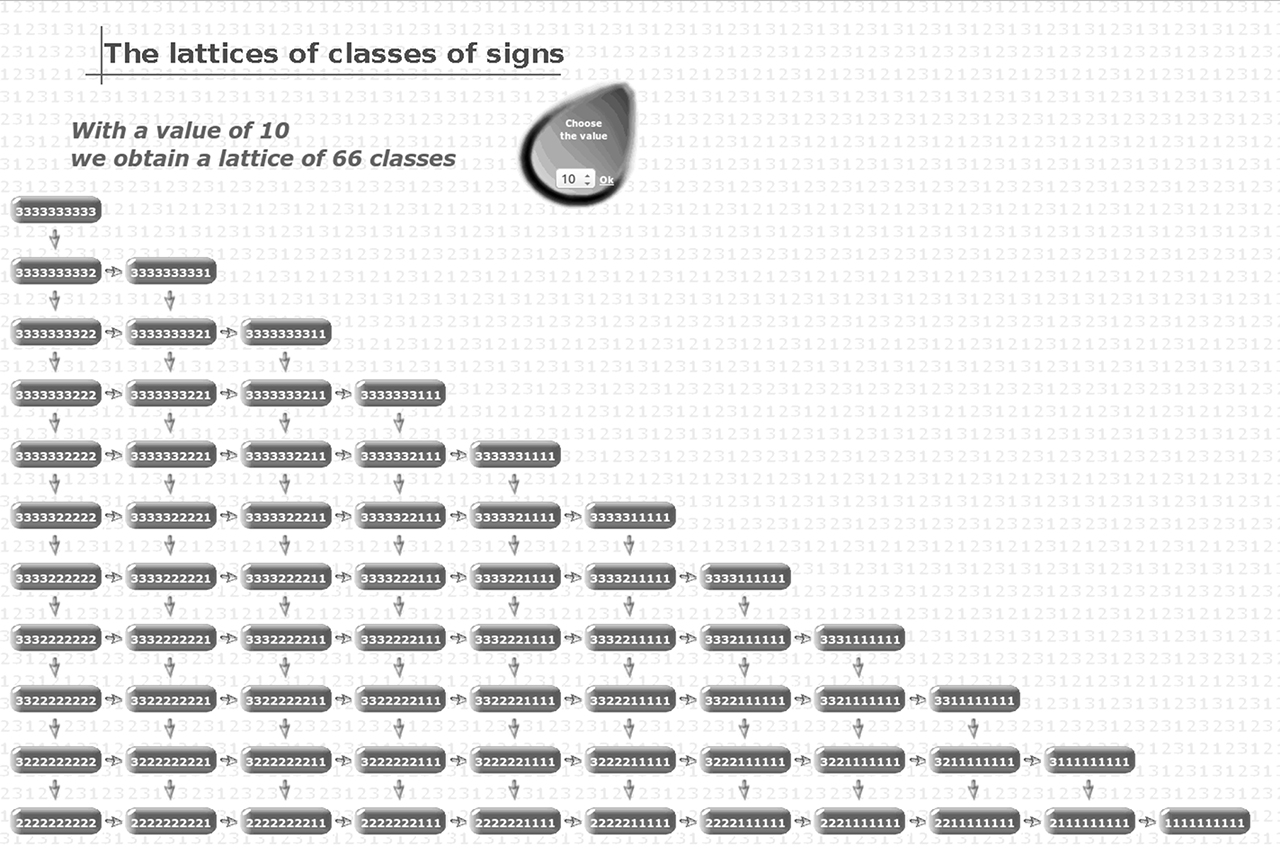Abstract
The formal analysis of the principles leading the classification of the hexadic, decadic, and triadic signs from C. S. Peirce especially, gives rise to a general methodology allowing to systematically classify any n-adic combinatory named “protosign.” Basic concepts of the algebraic theory regarding the categories and functors will be used. That formalization provides an additional benefit by highlighting and systematizing formal immanent relationships between the classes of protosigns (or signs). Well known hierarchical structures (lattices) are then obtained. Thanks to the contribution of specific concepts in the Homological Algebra, new methodologies of analysis and creation of significations can be introduced.
A Appendix

Copy of the result of the generator of latttices by Patrick Benazet for n=6. Every arrow represents a natural transformations of functors, that is to say, in this case 6 morphisms.
B Appendix

Copy of the result of the generator of lattices by Patrick Benazet for n=10. Every arrow represents a natural transformations of functors, that is to say, in this case 10 morphisms.
References
Marty, R. 1990. L’algèbre des signes: Essai de semiotique scientifique d’après C. S. Peirce. Amsterdam & Philadelphia: John Benjamins.10.1075/fos.24Search in Google Scholar
Marty, R. 2011. Seventy-six definitions of the sign by C. S. Peirce. http://www.iupui.edu/~arisbe/rsources/76DEFS/76defs.HTM (accessed 11 February 2019).Search in Google Scholar
Peirce, Charles S. 1931–1966. The collected papers of Charles S. Peirce, vol. 8. C. Hartshorne, P. Weiss & A. W. Burks (eds.). Cambridge: Harvard University Press. [Reference to Peirce’s papers will be designated CP followed by volume and paragraph number.].Search in Google Scholar
Peirce, Charles S. 1976. The new elements of mathematics, vol. 4. C. Eisele (ed.). Berlin & New York: Mouton de Gruyter. Atlantic Highlands, NJ: Humanities Press. [Reference to Peirce’s New Elements will be designated NEM followed by volume and page number].Search in Google Scholar
Peirce, Charles S. & Lady Victoria Welby. 1977. Semiotic and significs. Charles S. Hardwick (ed.). Bloomington: Indianapolis University Press. [Reference to this work will be designated SS followed by page number].Search in Google Scholar
© 2019 Walter de Gruyter GmbH, Berlin/Boston
Articles in the same Issue
- Frontmatter
- research article
- Introduction: Peirce’s extended theory and classifications of signs
- Semiosis is cognitive niche construction
- Peirce on facts, propositions, and the index
- Peirce on assertion and other speech acts
- Confidence through the semiotic process
- Diagrammatic relations of probative strength and inferential progression through semiotics
- On the immediate and dynamical interpretants and objects of signs
- Peirce and Dewey think about art: Quality and the theory of signs
- From phenomenology to ontology in Peirce’s typologies
- Reductionism in Peirce’s sign classifications and its remedy
- The trichotomic machine
- Peirce’s universal categories: On their potential for gesture theory and multimodal analysis
- On the transmodality of signs and their interpretants: Evidence from Peirce’s MS 599, Reason’s Rules
- Semeiotic completeness in the theory of signs
- Elements of Peircean phenomenology: From categories to signs by way of grounds
- Charles S. Peirce’s sign typology of 1903 and the semeiotic of universe, man, and culture
- Dimensions of Peircean diagrammaticality
- Index as scaffold to logical and final interpretants: Compulsive urges and modal submissions
Articles in the same Issue
- Frontmatter
- research article
- Introduction: Peirce’s extended theory and classifications of signs
- Semiosis is cognitive niche construction
- Peirce on facts, propositions, and the index
- Peirce on assertion and other speech acts
- Confidence through the semiotic process
- Diagrammatic relations of probative strength and inferential progression through semiotics
- On the immediate and dynamical interpretants and objects of signs
- Peirce and Dewey think about art: Quality and the theory of signs
- From phenomenology to ontology in Peirce’s typologies
- Reductionism in Peirce’s sign classifications and its remedy
- The trichotomic machine
- Peirce’s universal categories: On their potential for gesture theory and multimodal analysis
- On the transmodality of signs and their interpretants: Evidence from Peirce’s MS 599, Reason’s Rules
- Semeiotic completeness in the theory of signs
- Elements of Peircean phenomenology: From categories to signs by way of grounds
- Charles S. Peirce’s sign typology of 1903 and the semeiotic of universe, man, and culture
- Dimensions of Peircean diagrammaticality
- Index as scaffold to logical and final interpretants: Compulsive urges and modal submissions


